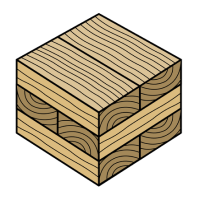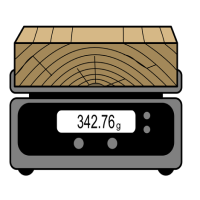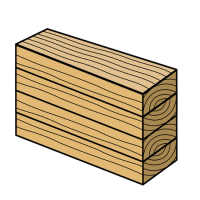What Causes Delamination in Cross-Laminated Timber (CLT) and How to Prevent It.

Sina Jahedi | Oregon State University, Graduate Research Assistant
Last updated: Oct. 16, 2023
In the past decade, cross-laminated timber (CLT) has become more mainstream thanks to its many advantages. The alternating layer-wise structure of CLT spreads the impact of defects over the whole panel and creates a more uniform material. Additionally, the perpendicular orientation of plies produces enhanced directional properties and increases dimensional stability .
Cross Laminated Timber (CLT) is made of at least three orthogonally oriented lamellas which are bonded together by glue. Delamination is a form of mechanical failure that can happen in laminated panels. In this article, we discuss:
- What is delamination in CLT?
- What causes the delamination in CLT?
- Why does CLT delamination matter?
- How to prevent delamination in CLT?
The most common adhesive systems used in making CLT are polyurethane (PUR), melamine-urea-formaldehyde (MUR), and melamine-formaldehyde (MF). CLT lamellas (plies) are oriented perpendicular to each other and bonded by structural adhesive. As a rule of thumb, a good bonding shall be stronger than the wood itself. In other words, if we apply excessive amounts of force to a CLT panel, the wood shall break, not the bonding line (adhesive). This allows us to use the full strength of wood.
What is Delamination in Cross-Laminated Timber (CLT)?
Merriam-Webster dictionary defines the term delamination as “separation into constituent layers”. However, in the wood industry, this term has a more specific meaning. In the wood industry, only the separations in bonding areas that are caused by adhesive failure are called delamination. As illustrated in the figure below, sometimes cracks grow very close to the bonding area which might seem like a delamination, but they are not! Wood fibers pulled off from both sides of the crack are an indication of wood failure, which shows the bonding was stronger than the wood itself, as intended. The term delamination is mostly used when the bonding fails, which appears as two clear surfaces with a gap in between.

Comparison of delamination vs. wood failure
What Causes Delamination in Cross-Laminated Timber (CLT)?
Basically, any force applied to the bonding area can cause delamination if the adhesive is not strong enough. Delamination can be caused by service loads, residual loads, self-weight loads, or (most commonly) the load induced due to the shrinkage of the wood. As the moisture content of wood changes, it starts to shrink or swell. Wood is an orthotropic material, meaning that the properties are directional. While wood shrinks significantly in radial and tangential directions, the shrinkage in the longitudinal direction is negligible. Having the plies of the CLT panel assembled perpendicular to each other, this difference in directional shrinkage can induce forces in the panel.
When CLT is drying or absorbing moisture, the bonding area tries to resist the difference in the shrinkage of lamellas. If the induced load is high enough, it can break the bonding between lamellas and cause delamination. If the bonding is stronger than the wood (which it should be), we will not observe any delamination in the CLT even with excessive moisture change. Instead the induced load form shakes and checks in the body of CLT.

Lamella shrinkage causing delamination in cross-laminated timber (CLT)
Why Does CLT Delamination Matter?
Widespread delamination reduces the strength of CLT panels significantly and can lead to total failure of the panel over time. The separated plies do not resist shear forces as much and the panel can buckle, even by its own weight.
Even the smallest cracks in the material can propagate into deep separations if the conditions are right. The cracks formed due to delamination typically have sharp tips. The local forces spike near the tip of cracks instead of evenly distributing in the area. This is called stress concentration, which can help the growth of crack and lead to total delamination of the plies. Additionally, delamination (or any crack in general) aids the penetration of moisture into the CLT panel which in turn leads to more and deeper delaminated areas.

Progression of delamination due to stress concentration at the tip of crack.
Delamination has a severe impact on fire development. The gap between layers acts as an oxygen supply channel and makes the underlying layer ignite instantaneously. This will increase the temperature enormously, prolong the fire duration, and make the extinguishing procedure more challenging.
How to Prevent Delamination in Cross Laminated Timber (CLT)?
The main causes of delamination are poor bonding and errors in handling of CLT panels. As stated in ANSI/APA PRG-320 (Standard for Performance-Rated Cross-Laminated Timber), the manufacturers have to run daily quality assurance tests on to ensure the compatibility of the adhesive with the wood species. As a part of the commercialization process, the CLT manufacturers shall send samples of their CLT panels to third-party certification agencies for performance tests. These precautions are set in place to ensure that no delamination would happen in the panel during production or at service. PRG-320 suggests conducting AITC T110 cyclic delamination test to check the compatibility of the adhesive and tuning the fabrication parameters if necessary. It is worth mentioning that AITC T110 test was originally developed for structural glued laminated timber (glulam), however due to similarities of CLT and glulam, this test is commonly used by CLT producers and researchers in North America.
As described in previous sections, moisture variations can lead to shrinkage of lamellas and cause delamination. It is recommended to keep the moisture content of lumber (during fabrication) as close as possible to the equilibrium moisture content of the end-use environment. For instance, a CLT panel that is going to be shipped to a hot and dry environment shall have less moisture content compared to the one shipped to a humid environment. Moreover, it is important to properly cover the CLT panels during transportation and installation to avoid moisture exposure.
Conclusion
Poor bonding and mishandling of cross-laminated timber (CLT) can cause delamination, which is a separation in bonding lines due to adhesive failure. Moisture content variations play a big role in the initiation and growth of delamination. Even the smallest cracks can propagate into total delamination of plies. However, strict quality assurance tests are mandated by the CLT standards to ensure that no panel would see delamination during production or service. Delamination prevention shall start from the early stages of fabrication by checking the compatibility of the adhesive and making sure that moisture content variations during transportation, installation, and service are as small as possible.




